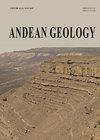作为阿根廷门多萨安第斯山脉中南部晚白垩世构造活动记录的迪亚曼特组冲积层
IF 1.2
4区 地球科学
Q3 GEOLOGY
引用次数: 1
摘要
Neuquén盆地的上白垩纪非海相矿床具有重要的区域暴露。这些矿床包含在Neuquén群中,这是盆地南部和中部一个经过充分研究的单元。然而,尚未详细研究迪亚曼特组的Laguna del Diamante和Atuel河之间暴露的最北端。在研究区域,Diamante组对应于一个具有中等弯度的辫状河流系统,随着时间的推移,该系统逐渐演变为网状河流系统。岩石学分析表明,砂岩属于长石岩屑砂岩和岩屑砂岩,而源区表明来源于再循环造山带和过渡弧。后者可能与位于西部的安第斯造山带的剥露和来自Neuquén盆地东北边界的输入有关,以目前暴露在圣拉斐尔区块的岩石为代表。在宏观尺度上,所测地层剖面的中上部存在钙质岩屑,强烈表明有来自西方的输入。这表明盆地极性发生了重要变化,并且根据研究区域南部等效矿床的先前建议,研究区域西部存在变形锋。本文章由计算机程序翻译,如有差异,请以英文原文为准。
Fluvial deposits of the Diamante Formation as a record of the Late Cretaceous tectonic activity in the Southern Central Andes, Mendoza, Argentina
The Upper Cretaceous nonmarine deposits of the Neuquén Basin have an important regional exposure. These deposits are included in the Neuquén Group, a well-studied unit in both the south and central part of the basin. However, the northernmost exposed between the Laguna del Diamante and the Atuel River-assigned to the Diamante Formation-have not been studied in detail. In the studied area, the Diamante Formation corresponds to a braided fluvial system with moderate sinuosity evolving through time towards an anastomosing fluvial system. Petrographic analyses indicate that sandstones belong to feldspatic litharenites and litharenites, while the source area indicates provenance from both a recycled orogen and a transitional arc. The latter could be linked to the exhumation of the Andean orogen located to the west and to the input from the north-eastern border of the Neuquén Basin, represented by the rocks currently exposed in the San Rafael Block. On a macroscopic scale, the presence of calcareous lithic fragments in the mid and upper part of the surveyed stratigraphic section, strongly suggest an input from the west. This indicates an important change in the polarity of the basin and the presence of a deformation front located to the west of the study area in accordance to previous proposals in equivalent deposits to the south of study area.
求助全文
通过发布文献求助,成功后即可免费获取论文全文。
去求助
来源期刊

Andean Geology
地学-地质学
CiteScore
3.90
自引率
0.00%
发文量
17
审稿时长
>12 weeks
期刊介绍:
This journal publishes original and review articles on geology and related sciences, in Spanish or English, in three issues a year (January, May and September). Articles or notes on major topics of broad interest in Earth Sciences dealing with the geology of South and Central America and Antarctica, and particularly of the Andes, are welcomed.
The journal is interested in publishing thematic sets of papers and accepts articles dealing with systematic Paleontology only if their main focus is the chronostratigraphical, paleoecological and/or paleogeographical importance of the taxa described therein.
 求助内容:
求助内容: 应助结果提醒方式:
应助结果提醒方式:


